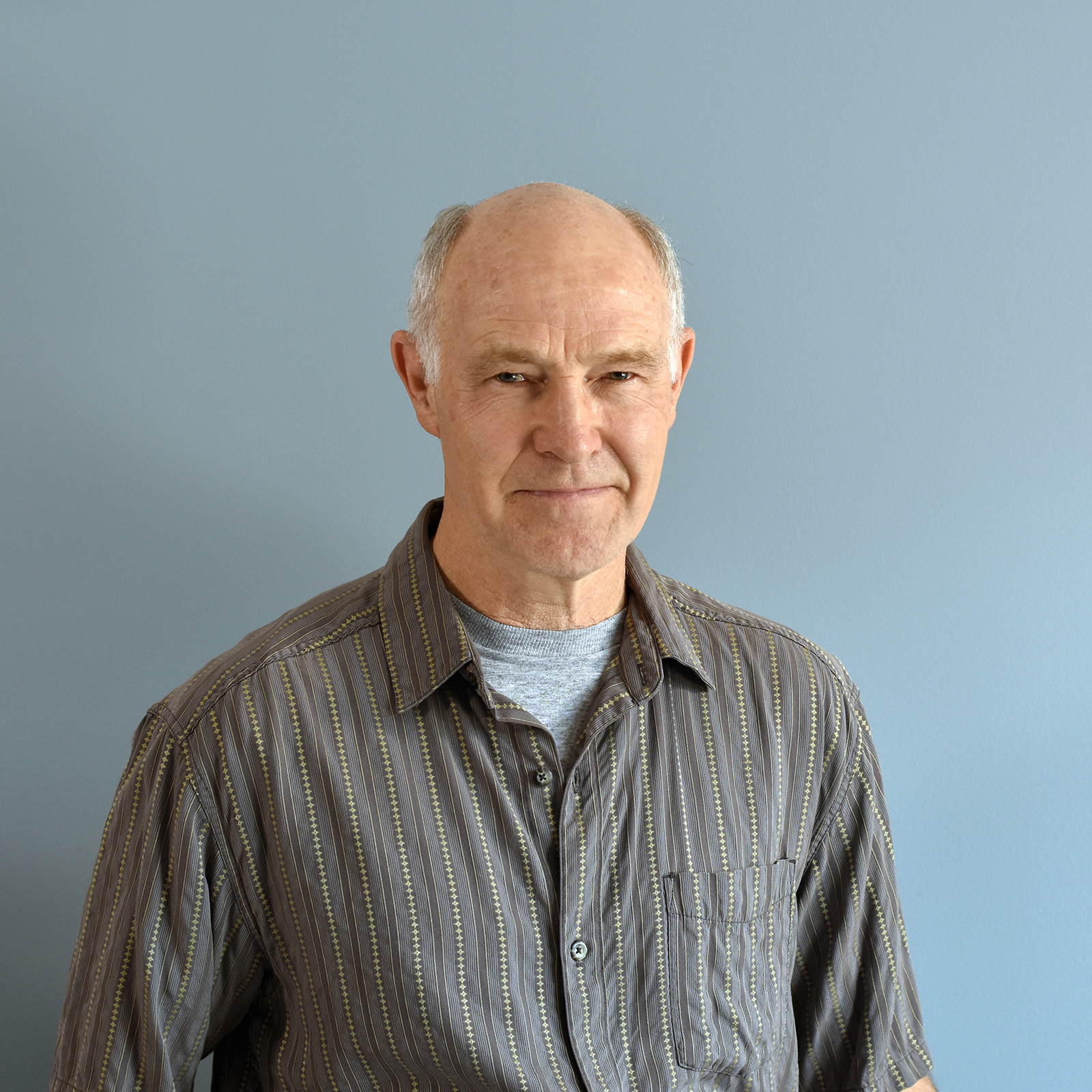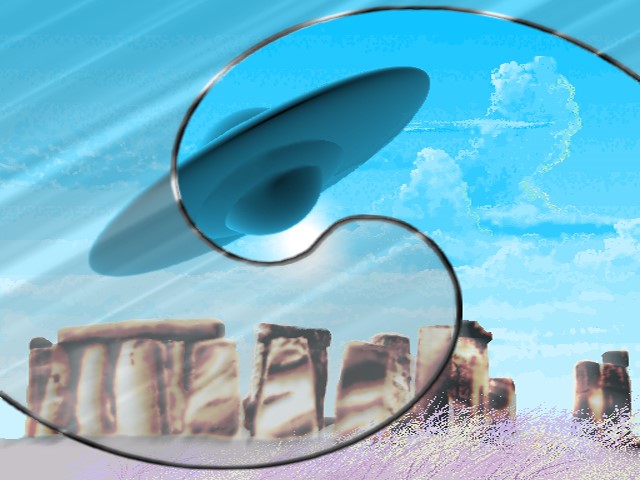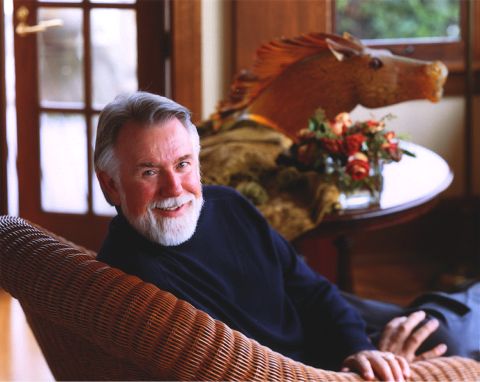Image created by the artists of NYIT Computer Graphics Lab and provided courtesy of Great Big TV LLC. Original name: “time.warp”, an image composition directed by Alvy Ray Smith, using efforts of Jim Blinn (saucer), David DiFrancesco (colorized Stonehenge), Paul Xander (clouds), Alvy (grass and Paint3 used for the clouds and grass), Ephraim Cohen (wrote the fn program used), and Lance Williams (chrome texture). One of many images created at NYIT CGL at various times in the 1970s (1975–79).
Are you looking for lively discussions to converge, collaborate, and explore big industry topics? Look no further than SIGGRAPH 2020 Panels! This year, we’re diving deeper as we Think Beyond and dig into the diverse perspectives of the SIGGRAPH community. To provide an inside look into what’s to come, we sat down with some of the panelists presenting “NYIT Computer Graphics Lab Then and Now” to learn more about their individual journeys and why SIGGRAPH 2020 is perfect for this discussion.
SIGGRAPH: Talk a bit about what inspired the idea behind the upcoming “NYIT Computer Graphics Lab Then and Now” Panel. Why did 2020 feel like the right year to share the history of this lab?
Hank Grebe (HG): First off, I’d like to mention that Alvy Ray Smith has written a book about the conception and life of the color pixel, which is due out next year. Looking at SIGGRAPH over the years, we are able see the development of the pixel … and now, here we are, the first virtual SIGGRAPH, and WE ARE THE PIXELS!
I hadn’t attended a SIGGRAPH Conference since 2000. Because of the [original] Washington, D.C. location, I planned to attend after recently moving to Virginia from California. I thought, “What could I bring to the conference? What might I contribute?” The idea of reviewing NYIT’s Computer Graphics Lab came up because, for me, the early SIGGRAPHs’ were synonymous with NYIT. I’ve kept in touch with people I worked with at NYIT over the years. Most of these computer graphics professionals moved on to successful careers with noteworthy companies and institutions, and yet mention that their experience working at “The Lab” was their favorite job.
Ed Catmull (EC): The work at NYIT was important and groundbreaking in many ways. It is now 45 years since it was started. Many significant people in the field of computer graphics passed through its doors; it was a remarkably unique lab with many memorable characters and events.
Alvy Ray Smith (ARS): It was [Hank’s] idea. I’m happy to take part [in the panel] as the NYIT Lab was an exciting and important part of the story of modern computer graphics. It was the finest CG lab in the world at the time. It was the origin of the group that eventually became Lucasfilm computer graphics, then Pixar. We made so many advances there that we lost track of them all. It was funded by the first of the three “moneymen” who paved our way to the big screen, but Alexander Schure — NYIT’s strange president — seldom receives any similar credit to George Lucas and Steve Jobs. He took the first big gamble on us and the idea of an all-digital movie. And, you have to understand, that the place was physically marvelous, too, mansions on large estates. Everything we touched was new. It was exciting to be alive. This [panel] is a celebration of that very special time and place.
Any year would work, but as the decades slip by, it becomes more and more important that the seminal events are noted. Some of the players are starting to die. Now’s the time.
Theresa Ellis Rygiel (TER): New millennium, new decade; a great time to mark the era of the beginning for Digital Visual Entertainment.
SIGGRAPH: Let’s go back a bit further than “The Lab”, as we hear it’s referred to. When and why did you decide to study computer graphics?
HG: In the ‘70s, I worked in traditional cel and stop-motion animation in art school and with a small studio in Boston called Lisberger Ladd Creations. In the early ’80s, Steven Lisberger wrote and directed “TRON” one of the first feature films to incorporate 3D computer animation. When I worked with Steve, we sometimes had to change colors on the inked acetate cels, and we would imagine digital painting systems. We didn’t know how they would be implemented; we just knew it would happen. “TRON” came out when I was at the University of Wisconsin and I promptly began catching up on computer graphics and programming. During this research I learned that Pat Hanrahan was working with the only color 3D graphics system on campus. I also heard about SIGGRAPH and attended 1983 in Detroit, where the NYIT Computer Graphic Lab staff gave a two-day course on their 2D animation system.
EC: My first computer graphics course was taught by Ivan Sutherland. I went to grad school to study computer language and only took the graphics course because it seemed to be interesting; it completely changed my life. The intersection of art and technology was not a theoretical construct — it was real, and this program at the University of Utah was at the frontier.
ARS: There was no “computer graphics” to study when I began. In fact, there were barely computers. I started out painting, as a kid, with oils and acrylics on canvas, before I learned about this new way to make pictures. A dear friend introduced me to Xerox PARC (Palo Alto Research Center), which had some of the very first color pixels in the world. The personal computer as we now know it was being invented there. I was introduced to digital painting there and “rolled my own” when I arrived at NYIT. I could have started in computer graphics a couple of years earlier but I wasn’t yet receptive. My first boss after getting my Ph.D. from Stanford was Herb Freeman at NYU. He had escaped the Nazis with the help of Albert Einstein. His specialty was this new-fangled field, computer graphics. Why not join him? I said I would just as soon as he had color. That’s where PARC came in: Color.
TER: I joined NYIT’s CGL from 1983–86. I have a Bachelor of Fine Arts degree and got a taste of digital technology in my senior year, taking my skills in graphic design onto the computer for exhibits at The Science Museum in Richmond, VA. I was then given contact to the very few individuals doing this sort of work up in New York. Sounded scary, but I made a visit there and got hired.
SIGGRAPH: Back to “The Lab”, what brought you to conduct research and study at the New York Institute of Technology (NYIT)?
HG: After SIGGRAPH ’83, I sent my animation demo reel to NYIT. A few weeks later I got a phone call from Lance Williams offering me an opportunity to visit the Lab and join a 2D production team staffed for a new “CGL West”. I felt like I received a message from Mount Olympus! I was part of the Lab’s effort to apply their research and produce 2D and 3D computer animation, to grow into a production studio like Disney.
EC: Alex Schure believed that computer graphics was going to change animation. He approached Dave Evans, who pointed him to me; and later Dave sent Alvy and David DiFrancesco out to NYIT. Malcom Blanchard had also been at Utah with me. So, the four of us were the founding group.
ARS: My artist pal David DiFrancesco and I had painted together at Xerox PARC. We sought an NEA (National Endowment for the Arts) grant to study art made with this new medium of color pixels. Xerox fired me (they decided not to do color), so David and I were in search of the next color pixels to satisfy that NEA grant. We found them at NYIT. Alexander Schure had bought the next set of color pixels into the world. So I talked my way in, noticing that Ed Catmull, who was already there, needed some help in getting his animation group off the ground. I did art, animation, and computers. It was a fit. The four of us who came together then (add Malcolm Blanchard) were together for many years afterwards, at Lucasfilm and Pixar. So I wasn’t there to “conduct research and study” but rather to make art with the best new color technology in the world. Of course, that involved research and study!
TER: I loved being a part of what felt like a huge new wave/world of technology and art. It all just made sense to me, combining the two and seeing where it would take us.
SIGGRAPH: In your research at “The Lab”, what was your most proud accomplishment?
HG: I was very interested in the 3D research going on at the Lab. Dick Lundin and Jules Bloomenthal were researching the geometric modeling of trees and jointed characters. I built a polygonal model of Gumby, receiving permission to do so from Art Clokey the creator of Gumby. Dick Lundin worked out a routine that enabled smooth joints in between limbs. I worked with Dick and our 3D animated Gumby character appeared in NYIT’s SIGGRAPH 1984 reel shown during the Electronic Theater. Art Clokey later visited the Lab, and during a SIGGRAPH in [Southern California] I visited him in Topanga Canyon.
EC: There was not a single accomplishment — there was so much going on that it was always exciting. The alpha channel, extending the fill algorithm to work with anti-aliased lines, the papers with Alvy, the first experimenting with motion blur, the Tween 2D animation system, new 3D rendering algorithms, and others. Probably the most impactful work, for me, was when Jim Clark implemented a new method for generating curved patches based on a paper I had written at the U; we then published a paper on this. Now, 40 years later, almost all surfaces used in special effects and 3D animation are based on this technique and it was given an Academy Award.
ARS: Oh, that’s hard to answer. We once sat down and tried to list all the firsts that we had accomplished at NYIT. The list got ridiculously long. Basically, everything we touched was a first. I’m proudest, I suppose, of my Paint3 program (the first paint program with full-color pixels and 16 megacolors), the alpha channel (that Ed Catmull and I invented), the body of art we created (much of it lost), learning to work with an animation studio (which Alex Schure had on campus for traditional cel animation of Tubby the Tuba – great training for us later).
TER: I was invited by Lance Williams to join in on a production project for Entertainment Tonight. We created a digital character we named User Abuser who was interviewed on the show by a reporter named Peter Quinn Hackes.
SIGGRAPH: For our currently studying readers, how does “The Lab” tie back to the conference and ACM SIGGRAPH?
HG: The Lab serves as a model example of an incubator, a startup, an innovative enterprise attempting to solve problems that have yet to be realized. Besides the human talent and research being done, there are real business and economic concerns that ultimately affect the life of the startup. The panelists have worked through a number of computer graphic business entities and have experienced advice regarding successes and failures.
Also, in a recent ACM webinar, Ed Catmull and Richard Chuang discussed the importance for new students of computer graphics to understand more of “what is under the hood”. NYIT CGL and other early research represent the core foundations of computer graphics.
EC: As I recall, everyone from the Lab went to that SIGGRAPH conference in Philadelphia, showing all our work. My belief was, and still is, that we show all our work and that we publish. It is an illusion to think that we get ahead by holding on to secrets. The real issue is: How do you attract the best people? You do this by encouraging publishing and open communication in a community. I have lifelong friends in the SIGGRAPH community.
ARS: We started attending the first SIGGRAPHs while at NYIT. We always chose SIGGRAPH as the place to announce our technical breakthroughs and to show off our art. We watched SIGGRAPH grow from 100s to 10,000s of attendees.
TER: It was a research lab. Continued education for whoever was interested and had something they wanted to contribute. It was filled with creative and highly intelligent individuals who were given the best opportunities to use their minds and talent with limitless encouragement. It was the kind of place that I wish for all students, and the only environment where truly inspiring ideas can be created.
SIGGRAPH: Share your all-time favorite SIGGRAPH memory.
HG: Seeing my Gumby animation shown at SIGGRAPH only a year after being an awestruck spectator was pretty special. Some of the reception parties were quite memorable, too. Digital Domain threw a company launch party during SIGGRAPH ’93 and it was a thrill to see James Cameron holding court, bump into Stan Winston, and see an amazing performance by Dweezil Zappa.
EC: The first two SIGGRAPH conferences were quite minor and I didn’t attend them. The third was in Philadelphia and my best memory was of a somewhat inebriated Jim Blinn dancing in the street. Steve Levine was chair for the following year. He and the other leaders conceived of a new format for the conference which started with two days of tutorials and then three days of conference. This overlapped with the film show, art show, and tradeshow. This was spectacularly successful and is pretty much the format for most of SIGGRAPH history. That next conference was in San Jose. The problem was that the hotel’s experience with most conferences was that many people don’t show up, so they overbooked their hotel. But in the case of SIGGRAPH, everyone showed up, so I entered the lobby only to find many luminaries really pissed off because the rooms they reserved weren’t available. The same thing happened the following year in Atlanta. They even over-booked the conference rooms! It took a while for the conference organizers to convince the hotels that the people who register for SIGGRAPH show up.
ARS: One of my highest points (not counting the special awards from SIGGRAPH) was the night we (then at Lucasfilm) premiered “The Adventures of André & Wally B”. It was our announcement to the world that we did character animation. George Lucas was there (secretly), and we were excited that he would see 5,000 screaming fans receive André & Wally. And that’s what happened. (Almost as personally gratifying was the night we premiered the Genesis Demo from “Star Trek II” to the SIGGRAPH crowd. There’s nothing like ecstatic celebration by one’s peers to make one feel good!)
TER: Seriously, my very favorite memory of SIGGRAPH is once a year catching up with friends and collegues from years past and present and sharing experiences, thoughts and discoveries (without sharing too many secrets) and being super proud that I could say I worked at NYIT’s CGL because they were the cool kids on the block for many years.
SIGGRAPH: What advice do you have for someone looking to submit to a future SIGGRAPH conference?
HG: Look around at innovations, leading-edge R&D, and use your imagination to wrap a concept around a topic that interests you. Then, explore and develop that concept further until you feel it is ready to submit to SIGGRAPH.
EC: We are in a field that is continuing to change. Computer graphics was part of a virtuous cycle where the algorithms of SIGGRAPH were implemented in the chip companies, such as Nvidia, sold into the games industry, put into cards accessible to academia and entertainment, leading to better algorithms that were published at SIGGRAPH. This cycle continued for many years, leading to so much processing power that Pat Hanrahan pointed out that the chips could be used in other fields, leading to the restarting of deep learning, which in turn is driving massive change today. Think broadly — there are many new problems and new ways to solve them.
ARS: Give us your best stuff.
TER: Being able to show clips and speak on current and significant past work which will encourage and engage students looking to also be the future leaders in our industry. With this type of ability through the current technology, it should be easy to have more of these panel opportunities throughout the year.
Want more Panels content? Enjoy scheduled sessions during SIGGRAPH 2020, 24–28 August. Don’t miss this group of panelists as they talk “NYIT Computer Graphics Lab Then and Now” on Thursday, 27 August at 8:30 am PDT.

Hank Grebe attended the School of the Museum of Fine Arts in Boston and did cel animation on Steven Lisberger’s short, “Cosmic Cartoon”. He studied computer graphics at the University of Wisconsin-Madison. He was an animator at NYIT’s Computer Graphics Laboratory from 1983–86 on commercial and research projects, showing a 3D Gumby animation in SIGGRAPH ’84’s Computer Animation Festival Electronic Theater, and a digital painter on PDI/DreamWorks’s “Shrek 2”. Hank worked in user experience design at AT&T Bell Labs, Time Warner, Sony, and Leica Geosystems. His 3D illustrations are represented by Adobe Stock, Getty Images/iStock, and Shutterstock.
Ed Catmull was the first director of the NYIT Computer Graphics Lab before moving on to Lucasfilm Ltd. and eventually Disney/Pixar. He co-founded of Pixar Animation Studios alongside Alvy Ray Smith, and served many years as president of Pixar Animation Studios and Walt Disney Animation Studios. He retired 49 years after taking the Ivan Sutherland class at the University of Utah, which, he says, “changed my life”.
Alvy Ray Smith co-founded Pixar Animation Studios. He has a Ph.D. from Stanford University and was the first CG director at Lucasfilm Ltd. and the first Graphics Fellow at Microsoft. Smith is a member of the National Academy of Engineering (NAE), a fellow with the American Association for the Advancement of Science (AAAS), a founding inductee into the ACM SIGGRAPH Academy, and holds an honorary doctorate from New Mexico State University (NMSU), among many other accolades. In addition to holding four U.S. patents, he has been honored with two technical Academy Awards (for paint programs and alpha compositing) and helped initiate the Visible Human Project as regent for the National Library of Medicine. He resides in Berkeley, CA with his wife and two sons.
Theresa Ellis Rygiel began her career developing artists’ tools at NYIT from 1983–86. She is a member of AMPAS and works on the executive committees for Visual Effects Branch and Student Academy Awards. Her on-set VFX work includes New Line’s “Nativity Story” in Italy and Morocco, “Martian Child” in Vancouver, Warner Bros.’ “Conspiracy Theory” in L.A., “Stepmom” in New York, and from digital artist to digital effects supervisor on “The Lord of the Rings” trilogy. She was a CompSup on Marvel Studios’s “Guardians of the Galaxy” and “Dr. Strange”, and for Universal Studios on “Furious 7”, “Fast 8”, and “Dolittle”.






